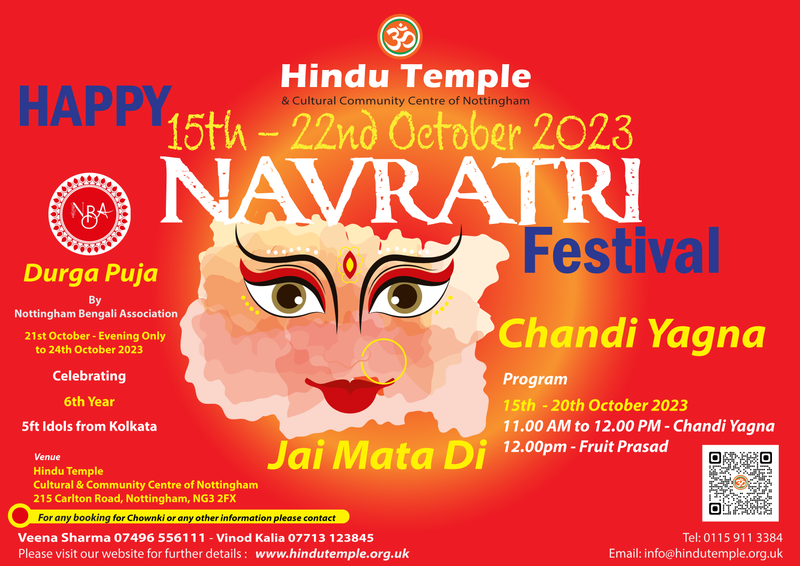Program: 8:00 AM Morning Puja 6:00 PM - 7:30 PM Evening Puja (Aarati, Pushpanjali) 7:30 PM Cultural Program 8:00 PM Prasad/Dinner Day 7 - Saptami: On the seventh day, people worship Goddess Kalaratri. She is a fierce and dark form of Durga, symbolizing the destruction of ignorance and evil. This day is about seeking protection from negativity.
- Date: 21/10/2023 18:00 - 21/10/2023 20:00
- Location 215 Carlton Road, Nottingham, UK (Map)
- More Info: Hindu Temple Cultural and Community Centre of Nottingham
Description
Navratri is a significant Hindu festival celebrated in India with great enthusiasm and devotion. It lasts for nine nights and is dedicated to the worship of the Goddess Durga in her various forms. The word "Navratri" is derived from two Sanskrit words: "Nav" meaning nine and "Ratri" meaning night. This festival typically falls in the Hindu calendar month of Ashwin, which usually falls in September or October in the Gregorian calendar.
Here's an explanation of each of the nine days of Navratri from an Indian Hindu perspective:
Day 1 - Pratipada: On the first day of Navratri, Goddess Shailaputri is worshipped. She is the daughter of the mountain king, also known as Parvati. Devotees offer prayers and seek blessings for their well-being and prosperity.
Day 2 - Dwitiya: The second day is dedicated to Goddess Brahmacharini, a symbol of divine feminine energy. She is believed to be an embodiment of penance and devotion. Devotees seek strength, wisdom, and virtue by worshiping her.
Day 3 - Tritiya: On the third day, Goddess Chandraghanta is revered. She is depicted with a crescent moon on her forehead, symbolizing peace and tranquility. This day is about seeking courage and protection from her.
Day 4 - Chaturthi: Goddess Kushmanda is worshipped on the fourth day. She is believed to be the creator of the universe, and her name means "the cosmic egg." Devotees pray for health, happiness, and strength.
Day 5 - Panchami: Skandamata, the mother of Lord Skanda (Kartikeya), is honored on this day. She represents motherly love and protection. People seek her blessings for the welfare of their children.
Day 6 - Shashthi: Katyayani, the warrior goddess, is venerated on the sixth day. She is believed to have been born to sage Katyayana and is considered a fierce form of Durga. Devotees seek her blessings for courage and strength.
Day 7 - Saptami: On the seventh day, people worship Goddess Kalaratri. She is a fierce and dark form of Durga, symbolizing the destruction of ignorance and evil. This day is about seeking protection from negativity.
Day 8 - Ashtami: Maha Gauri, the eighth form of Durga, is worshipped on this day. She is a symbol of purity and serenity. Devotees pray for purity of mind and soul.
Day 9 - Navami: On the ninth day, Goddess Siddhidatri is revered. She is believed to bestow knowledge and spiritual realization. Devotees seek her blessings for enlightenment and liberation.
These nine days are often accompanied by fasting, prayer, music, dance, and various cultural celebrations, including Garba and Dandiya Raas dances in many parts of India. Navratri is a time for spiritual reflection, devotion, and connecting with the divine feminine energy that permeates the universe. It's a celebration of the triumph of good over evil and the renewal of faith and hope in the hearts of devotees.



